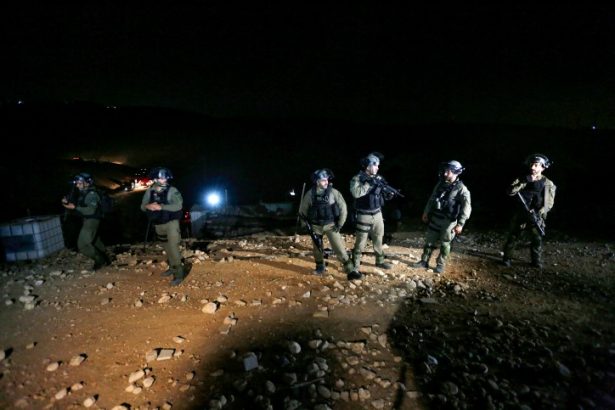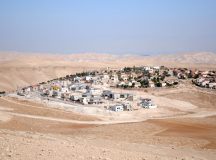Naomi Linder Kahn is Director of the International Division at Regavim, an NGO dedicated to the ‘preservation of Israel’s resources through universal and unbiased enforcement of law’. In this essay, Kahn attempts to strip back the conflicting narratives over the imminent destruction of the Bedouin village of Khan al Ahmar to what she says are the simple facts of the matter: that the village is an illegal outpost; that it is built on land which belongs to the State of Israel; and that the state is not required by law to provide compensation for the inhabitants but is doing so nonetheless. Download a PDF version here. For a contrasting analysis read Hagit Ofran here.
Khan al Ahmar, a small and otherwise unremarkable Bedouin encampment situated on Israel’s Highway No. 1, has become a test case – in more ways than might have been reasonably expected. There are those who describe Khan al Ahmar as a showcase for the State of Israel’s prejudicial land allocation policy. Others point to the case of Khan al Ahmar as a glaring instance of Israeli inhumanity, injustice, and even criminality.
In fact, Khan al Ahmar is neither.
Here are the facts: Khan al Ahmar is an illegal outpost, built on land that belongs to the State of Israel. It is situated in an area under full Israeli administrative and security jurisdiction according to both the Oslo Accords and international law, in the heart of an area that is strategically critical to Israel’s future. It was built by the Palestinian Authority (PA) with funds provided by the EU and its member-states, for purely political purposes. Both the PA and the EU continue to champion the ‘cause’ of Khan al Ahmar ‘in order to ensure the viability of the Palestinian State’ in Area C. Just to be clear: The signatories of an international treaty (the PA and the EU) are doing everything in their power to undermine that treaty, publicly proclaiming their intention to make the most basic principle of that treaty (namely, a negotiated resolution of the status of the territory) redundant. At the same time, they are accusing the other party to the treaty (Israel) of violating international law. The Jahalin Bedouin of Khan al Ahmar are merely pawns in this bizarre power play.
First, some background: As a result of the 1995 Interim Agreement (‘The Oslo Accords’), Judea and Samaria were divided into three areas. Arab population centres were placed under the auspices of a newly-created Palestinian administration, and huge amounts of land registered to and owned by the State of Israel were transferred to Palestinian control. The territory classified as Area A (under full Palestinian administrative and security jurisdiction) and Area B (under Palestinian administrative jurisdiction and Israeli responsibility for peripheral security) includes thousands of dunams of land owned by the State of Israel which were ceded to Palestinian control. Much of this land is still available to the PA for the creation of housing solutions, new neighbourhoods, grazing and agricultural use, industrial and commercial use, or any other use that the PA deems necessary. If a Palestinian resident wants to build a home or business in Area A or B, he need only submit a request to the PA – the State of Israel has absolutely nothing to do with it. Much of this land remains empty to this very day; there is no shortage of options available to the PA for land allotment in Areas A and B – only a shortage of political motivation. On the other hand, if a Jew buys property in these areas, the result is a death sentence for both the seller and the buyer.
Israel’s most vocal critics conveniently neglect to include the massive tracts of land ceded to the PA under the Oslo Accords when calculating land allocation statistics. These critics are interested only in land that remains in Israeli hands, demanding ever greater slices of the much-reduced pie. Have any of these critics considered the idea that the PA should, by the same token, be required to allocate land resources in Areas A and B equally to the Arab and Jewish sectors? After all, the statistics in Areas A and B are far more one-sided than in Area C; not one centimetre of this land – particularly land owned by the State of Israel that was ceded under the Oslo Accords – has been allocated for Jewish use. The fact that any land in Area C has been allocated to the ‘Palestinian sector’ is what should be considered truly remarkable.
Palestinian complaints regarding Israel’s land allocation policy in Judea and Samaria may be summed up by the ancient rabbinic adage, ‘What is mine is mine, and what is yours is mine.’
What, then, of the charge that the evacuation of Khan al Ahmar would constitute a war crime?
Human rights in the areas under Israeli control are the subject of intense national and international scrutiny, and in this area, as well, Khan al Ahmar has become a symbol in the war of delegitimisation. In recent months, the PA, anti-Zionist NGOs, European governments, and the EU have threatened the State of Israel with prosecution in the International Criminal Court for war crimes arising from supposed ethnic cleansing in the Maaleh Adumim (‘E1’) region. In fact, although no formal hearing of these charges has been conducted, ICC Prosecutor Fatou Bensouda released a statement warning Israel that the case of Khan al Ahmar is under ‘preliminary examination’ by her office; presumably, this examination will give the same consideration for the facts of the case that has thus far been afforded to the narrative presented by the PA.
Here are facts: The residents of Khan al Ahmar are one branch of the large Jahalin Bedouin tribe. Until fairly recently, they were nomadic shepherds who lived, with the rest of the tribe, near Arad, and moved their herds and tents around southern Israel with the changing seasons. At some point, a feud broke out between different branches of the tribe and this branch of the extended family was forced out of the Arad area. The Israeli government did not ‘banish’ these Bedouin from the Negev, as is often claimed; the Jahalin ran for their lives to escape intra-tribal violence. Travelling northward, they restricted their migratory grazing routes to the section of the Judean Desert bordering the eastern approaches to Jerusalem where, like most of the world’s nomadic populations in the past 100 years, they underwent a process of urbanisation, abandoning a fully nomadic lifestyle in favour of more standard, modern forms of livelihood.
Aerial photos paint a clear picture of the history of Khan al Ahmar: The Jahalin arrived in the Adumim region in the mid-1970s after the Yom Kippur War of 1973. The encampment began to take shape in the 1980s on the main traffic artery connecting Jerusalem, Maaleh Adumim, and the Dead Sea beyond, consisted of two or three tents and a few makeshift storage structures. Some 80 per cent of the heads of the Jahalin households in the E1 region worked in Maaleh Adumim, Mishor Adumim, and other neighbouring Jewish communities.
From their very first day on the site, the Jahalin were well aware that the land they had squatted on was within the municipal boundaries of Kfar Adumim. They also knew that this location was not a long-term solution for their housing needs. In the early 1990s, the State of Israel signed and implemented a relocation agreement with the majority of the families at Khan al Ahmar. The agreement provided each family with a substantial plot of land near Abu Dis, an Arab neighbourhood on the eastern approaches to Jerusalem that has, since then, been classified as Area B – complete with building rights, infrastructure for water and electricity, and access to paved roads, public transportation, and grazing land. Some 20 families refused to sign, among them households that already owned permanent residences in Abu Dis and Al Azariya.
The families that remained at Khan al Ahmar, who continued to negotiate for a more generous relocation package, soon became entangled in a much larger political struggle: In 2009, Salam Fayyad, then prime minister of the PA, published his master plan for the creation of a Palestinian state. The basis of the Fayyad Plan was – and remains – the creation of a de facto state without the need for negotiation with Israel, through the creation of facts on the ground in areas under full Israeli jurisdiction. One of the areas most strategically essential to the Fayyad Plan’s vision of Palestine runs directly through the Adumim region.
The moment the Fayyad Plan was published, the PA and the EU jumped right in, creating a network of illegal settlements that formed a contiguous band of territory, the spinal column, as it were, of the envisioned Palestinian state.[1] The tactics employed by the PA to create this string of illegal settlements were methodical, and were repeated over and over throughout Area C: First, water tanks were placed on sites the PA had slated for seizure. In the second stage, once the Bedouin set up camp around these accessible and free-of-charge water sources, schools were built to attract population.
Khan al Ahmar is the flagship outpost of this network. The PA and EU began pumping money into Khan al Akhmar while reinventing the narrative of the Bedouin camp’s residents. An Italian NGO, Vento de Terra, built a school on the site and began to bus in Bedouin children from all across the region – children who would otherwise have continued their education at the school in Jericho, a 15-minute ride away. At the same time, the PA, the EU, and a shadow lawfare organization called The Society of St. Yves worked overtime to force the Jahalin to step away from the relocation agreement that had been signed earlier with the Israeli government. In a ceremony at Khan al Ahmar in May 2011, Fayyad dubbed the residents of Khan al Ahmar ‘soldiers of the PA.’ International ‘human rights’ organisations joined the fray, as well. The negative media attention and unlimited funding for the PA’s legal stalling techniques, provided by the EU, took a heavy toll on the State of Israel’s resolve to defend its own critical interests and enforce the law.
In six separate lawsuits (docket numbers 6288/09, 5665/11, 7969/13, 3287/16, 2242/17, and 9249/17), Israel’s highest court confirmed that the Bedouin encampment at Khan al Ahmar is illegal and must be evacuated. In the fifth and final round of Supreme Court hearings (May 2018), the PA-funded lawyers ‘representing’ the residents of Khan al Ahmar announced that no compromise would be accepted; the only resolution they are willing to consider is the official recognition of the ‘village’ at its present location.
Although the Jahalin have never claimed ownership of the land on which Khan al Ahmar sits, the Supreme Court required the Israeli government to create an alternative for this very vulnerable population, and the Israeli government promptly set aside state land for a new neighbourhood on the outskirts of Abu Dis, named Jahalin West. The relocation site, located in Area C, is close enough – but not too close – to the Jahalin families that relocated years ago. Once again, the state offered a relocation package, worth over half a million Shekels for each wife in each of the Jahalin households – a package that includes a large plot of land, completely developed and zoned for residential construction, with infrastructure for water and electricity. The new neighbourhood offers services that the Jahalin who were left behind can only dream of today – services the PA and the EU have never offered them: Health clinics, public transportation, proper schools, access to employment, and more, all free of charge, at the expense of the Israeli taxpayer – turning the claim of prejudicial land allocation policy completely on its head. No such offer has ever been made to Israeli citizens.
In off-the-record conversations, the Jahalin of Khan al Ahmar say they are not only willing but eager to relocate and to begin to build their lives in a modern, legal neighbourhood. But they will also tell you about how they are threatened by the PA and the Europeans, who will not allow them to relinquish their hold on the strategic piece of land on which Khan al Ahmar sits. Testimony regarding these threats is part of the record of Supreme Court hearings.
The Supreme Court’s final decision stated clearly that the state had proven unprecedented willingness to reach an agreement with the squatters, and had prepared a viable alternative at great public expense. There was no longer any reason to suspend the demolition orders. The Civil Administration then notified the residents of the encampment that they were required to evacuate by 1 October, and offered relocation assistance. Nonetheless, the deadline was postponed several more times, and the resolution of this issue remains unclear.
While the territory in question falls under the category of ‘contested land’[2] according to international law, the PA and its supporters have initiated steps in international forums to charge Israel with war crimes, specifically, the forced relocation of a protected population in ‘occupied territory’. Aside from the baseless categorisation of E1 and more generally of Area C as occupied territory, these recent claims are unfounded: Even if the claim that Area C is ‘occupied territory’ were supported by international definitions, the fact remains that Khan al Ahmar was built illegally, without any planning or zoning permits issued by the ‘occupying authority’ – which is solely responsible for these permits under the Geneva Conventions.
Furthermore, the inhabitants of Khan al Ahmar are not indigenous, nor have they ever claimed any legal rights to land in the area. Although the Jahalin began grazing in this area in the 1970s, Khan al Ahmar did not exist prior to 2009. The very first permanent structure at the site was the mud-and-tire school, built in 2009. When the State of Israel became responsible for this area in 1967 (either as an occupier, a liberator, an administrative caretaker, or in any capacity one may choose to define the Israeli presence), the current residents of Khan al Ahmar were completely absent; the same was true at the time the Oslo Accords were signed. Therefore, the State of Israel has no responsibility to compensate these squatters for their illegally-constructed homes and is not obligated to allow them to continue to reside in the E1 area- neither under the Oslo Accords nor under international law.
The protection provided by international law for those residing in ‘occupied territory’ pertains to property rights. The law does not allow illegal behaviour, nor does it protect unsanctioned land use or unlicensed construction. Thus, even if Israel is considered an occupying power – which is not the position of the Israeli or US governments, and is a categorisation not supported by the language of the Geneva Conventions or the Rome Treaty – and even if the residents of this and other illegal outposts claim to have an historic connection to the land on which they are squatting – which they do not – they would still not be allowed under international law to engage in illegal construction.
Aside from violating the spirit and the ultimate goals of the Oslo Accords, the location of Khan al Ahmar is a flagrant violation of Annex I, Article 12, section 2 of the Accords, which stipulates that ‘buildings or installations shall not be constructed or erected … on either side of the roads delineated in blue on map No. 7 up to a distance of 50 meters from the center of these roads … Any buildings or installations constructed or erected contrary to this paragraph shall be dismantled’. In other words, the evacuation and demolition of Khan al Ahmar also falls under the principle of lex specialis derogat generali, a basic tenet of international law stipulating that specific contractual obligations – in this case, articles of the Oslo Accords – supersede more general, ‘customary’ sources of law that may or may not have justified this outpost’s creation.
The PA, the EU, and various anti-Zionist organizations have accused Israel of violating the Geneva Convention, which prohibits the forcible transfer of protected populations out of occupied territory. While this is an accurate reading of the law, it is simply not applicable to the matter of the Jahalin of Khan al Ahmar, who have been provided with an alternative, permanent, legal relocation site within the same territorial unit (‘Area C’), only five kilometres away from their present location. Furthermore, Jahalin West was planned in a manner that will preserve the social and cultural constructs of this tribal unit and enable the relocated families to maintain their traditional lifestyle.
In short: The claims levelled against the State of Israel are nothing more than cynical manipulation. The PA, its European benefactors, and the cabal of anti-Zionist NGOs who espouse the specious PA-generated narrative of Khan al Ahmar are using the vulnerable Jahalin Bedouin of the Judean Desert as pawns in a programme of territorial conquest and demonisation of Israel. The facts of the case tell a different story altogether.
[1] Regavim documented dozens of examples of this pattern throughout Area C. See our report, ‘Illegal EU-Funded Construction in the Adumim Region.’
[2] For an overview of the differences between the legal terms applied to Judea and Samaria, see Gold, Dore (16 January 2002): ‘From ‘Occupied Territories’ to ‘Disputed Territories’. Jerusalem Center for Public Affairs (Israeli Security, Regional Diplomacy, and International Law). Additional resources: ‘Israeli Military Orders List’ p. 1. (israellawresourcecenter.org); Yehuda Z. Blum ‘The Missing Reversioner: Reflections on the Status of Judea and Samaria’, Israel Law Review 279 (1968).





































